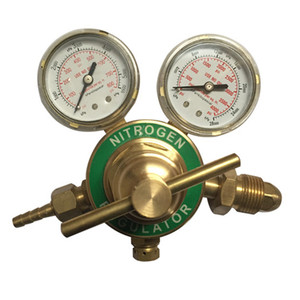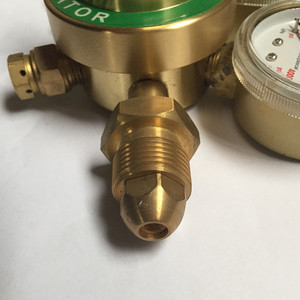
All categories
Featured selections
Trade Assurance
Buyer Central
Help Center
Get the app
Become a supplier

(2330 products available)











































In the realm of testing instruments and equipment, nitrogen high pressure regulators play a crucial role in regulating pressure within various systems. These devices are designed to maintain a consistent pressure level, ensuring the optimal performance of machinery and systems across different industries. nitrogen high pressure regulators are essential for preventing overpressure scenarios that can lead to equipment failure or safety hazards. They serve as vital components in applications ranging from industrial machinery to laboratory setups, making them indispensable in the field of pressure management. The versatility and reliability of nitrogen high pressure regulators make them a mainstay in both commercial and technical environments.
There are several types of nitrogen high pressure regulators designed to cater to different applications and requirements. Common types include direct-operated regulators, pilot-operated regulators, and vacuum regulators. Direct-operated regulators are simple and cost-effective, ideal for applications where precise control is not critical. Pilot-operated regulators offer more precise control and are suitable for high-pressure applications. Vacuum regulators are specialized nitrogen high pressure regulators used to maintain a consistent vacuum level in systems. Each type of nitrogen high pressure regulators is engineered to handle specific pressure ranges and flow capacities, ensuring that they meet the demands of their intended applications. The selection of the appropriate type of nitrogen high pressure regulators is crucial for achieving optimal performance and safety.
The primary function of nitrogen high pressure regulators is to maintain a stable output pressure despite variations in input pressure or flow demand. They are equipped with features such as adjustable pressure settings, built-in relief valves, and pressure gauges. Adjustable pressure settings allow users to customize the output pressure according to specific requirements. Built-in relief valves ensure safety by preventing excessive pressure buildup. Pressure gauges provide real-time monitoring of pressure levels, enabling users to make informed adjustments. The precision and reliability of nitrogen high pressure regulators are critical in applications where maintaining consistent pressure is essential for operational efficiency and safety.
nitrogen high pressure regulators are constructed using robust materials that ensure durability and longevity. Common materials include stainless steel, brass, and aluminum, chosen for their resistance to corrosion and wear. Stainless steel is often used for high-pressure applications due to its strength and corrosion resistance. Brass is favored for its excellent machinability and moderate resistance to corrosion, making it ideal for general-purpose nitrogen high pressure regulators. Aluminum offers a lightweight alternative, suitable for applications where weight is a concern. The construction of nitrogen high pressure regulators is designed to withstand harsh environments and demanding operational conditions, ensuring reliable performance over extended periods.
Proper installation and maintenance are crucial for the effective functioning of nitrogen high pressure regulators. During installation, it is important to ensure that the regulator is correctly aligned with the flow direction and securely mounted. Regular maintenance involves checking for leaks, calibrating pressure settings, and cleaning internal components to prevent blockages. Performing routine inspections helps identify potential issues before they escalate, ensuring the continued performance and safety of the system. Understanding the specific requirements of nitrogen high pressure regulators and adhering to manufacturer guidelines are essential for maximizing their lifespan and efficiency.
When selecting nitrogen high pressure regulators, several factors should be considered to ensure compatibility with specific applications. The first consideration is the pressure range that the regulator will handle. It's essential to match the regulator's capacity with the system's requirements to prevent any operational inefficiencies or safety risks. Additionally, the type of fluid or gas being regulated, whether it be air, water, or hazardous chemicals, will influence the choice of nitrogen high pressure regulators. Compatibility with materials and construction must be verified to ensure durability and safe operation. Environmental conditions, such as temperature and humidity, should also be assessed, as they can affect the performance of nitrogen high pressure regulators.
Another crucial aspect is the flow capacity of nitrogen high pressure regulators. Different applications require varying flow rates, and selecting a regulator that can handle the necessary flow without compromising pressure stability is vital. Size and weight considerations are also important, especially in applications with space constraints or where portability is a factor. Furthermore, the ease of installation and maintenance should be evaluated, as these can impact long-term operational efficiency. Some nitrogen high pressure regulators offer features such as tool-free adjustments or modular designs that simplify maintenance tasks. Ensuring that the chosen regulator meets all these criteria will contribute to optimal system performance.
nitrogen high pressure regulators are commonly used in a variety of applications, including industrial machinery, medical equipment, and laboratory setups. They play a crucial role in maintaining consistent pressure for pneumatic systems, hydraulic systems, and gas distribution networks. In medical settings, they ensure precise delivery of gases for respiratory therapy and anesthesia. Laboratory applications often require nitrogen high pressure regulators for accurate control of gas flow in experiments and processes.
nitrogen high pressure regulators are equipped with safety features such as built-in relief valves and pressure gauges to prevent overpressure scenarios. Relief valves automatically release excess pressure to protect the system from damage. Pressure gauges provide real-time monitoring, allowing operators to make necessary adjustments to maintain safe pressure levels. These features are essential for ensuring safety and preventing equipment failure in high-pressure environments.
Yes, nitrogen high pressure regulators can be designed for use with both gases and liquids. However, it's important to select a regulator specifically engineered for the intended medium. Materials and construction must be compatible with the fluid or gas to prevent corrosion and ensure reliable operation. Some nitrogen high pressure regulators are versatile enough to handle multiple types of media, but verifying their suitability for specific applications is crucial.
Regular maintenance of nitrogen high pressure regulators includes checking for leaks, calibrating pressure settings, and cleaning internal components to prevent blockages. Routine inspections should be conducted to identify signs of wear or damage. It's important to follow manufacturer guidelines for maintenance intervals and procedures to ensure long-term reliability and performance. Proper maintenance helps extend the lifespan of nitrogen high pressure regulators and ensures safe operation.
nitrogen high pressure regulators can be customized with various features to meet specific application needs. Options such as adjustable pressure settings, modular designs, and specialized materials allow for tailored solutions. Some applications may require specific inlet and outlet configurations or additional components like filters and silencers. Customization ensures that nitrogen high pressure regulators can efficiently handle unique operational requirements and environmental conditions.